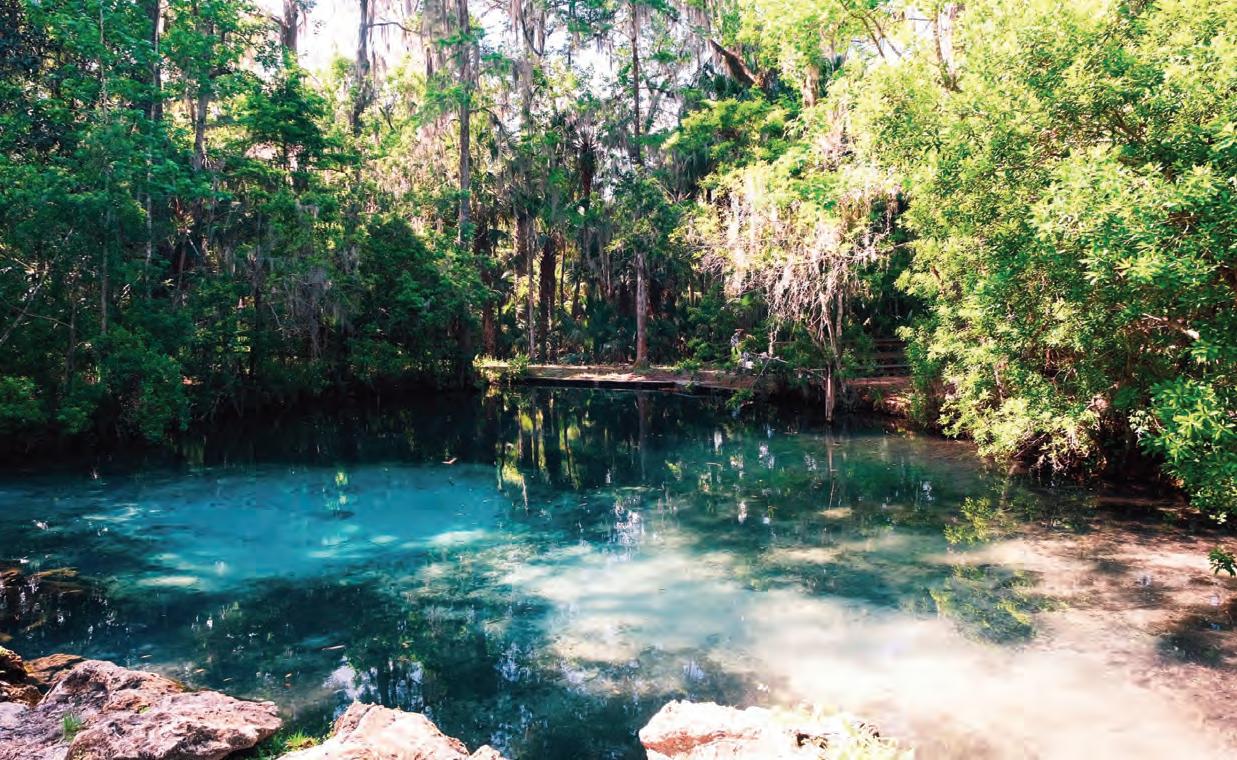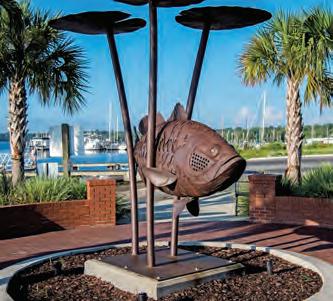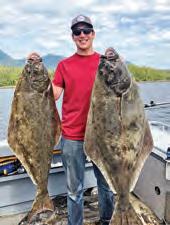


































Located within two hours driving distance to all major attractions in central Florida, international airports and Florida’s beautiful beaches, Putnam County’s outdoor recreational choices are legendary. Between world class fishing, boating, hunting, cycling, hiking, golf, and more, Putnam County has it all. Whether you are seeking real Florida culture and heritage, recreation, or just relaxing in a small historic town, the residents and businesses of Putnam County invite you to Experience Real Florida























Travel the globe, without leaving home—with this set of the world’s ve most popular pure silver coins. Newly struck for 2023 in one ounce of ne silver, each coin will arrive in Brilliant Uncirculated (BU) condition. Your excursion includes stops in the United States, Canada, South Africa, China and Great Britain.
Each of these coins is recognized for its breathtaking beauty, and for its stability even in unstable times, since each coin is backed by its government for weight, purity and legal-tender value.


2023 American Silver Eagle: The Silver Eagle is the most popular coin in the world, with its iconic Adolph Weinman Walking Liberty obverse backed by Emily Damstra's Eagle Landing reverse. Struck in 99.9% fine silver at the U.S. Mint.






2023 Canada Maple Leaf: A highly sought-after bullion coin since 1988, this 2023 issue includes the FIRST and likely only use of a transitional portrait, of the late Queen Elizabeth II. These are also expected to be the LAST Maple Leafs to bear Her Majesty's effigy. Struck in high-purity



99.99% fine silver at the Royal Canadian Mint.
2023 South African Krugerrand: The Krugerrand continues to be the best-known, most respected numismatic coin brand in the world. 2023 is the Silver Krugerrand's 6th year of issue. Struck in 99.9% fine silver at the South African Mint.





2023 China Silver Panda: 2023 is the 40th anniversary of the first silver Panda coin, issued in 1983. China Pandas are noted for their heart-warming one-year-only designs. Struck in 99.9% fine silver at the China Mint.

2023 British Silver Britannia: One of the Royal Mint's flagship coins, this 2023 issue is the FIRST in the Silver Britannia series to carry the portrait of King Charles III, following the passing of Queen Elizabeth II. Struck in 99.9% fine silver.




These coins, with stunningly gorgeous finishes and detailed designs that speak to their country of origin, are sure to hold a treasured place in your collection. Plus, they provide you with a unique way to stock up on precious silver. Here’s a legacy you and your family will cherish. Act now!
You’ll save both time and money on this world coin set with FREE shipping and a BONUS presentation case, plus a new and informative Silver Passport!
2023 World Silver 5-Coin Set Regular Price $229 – $199 SAVE $30.00 (over 13%) + FREE SHIPPING




FREE SHIPPING: Standard domestic shipping. Not valid on previous purchases. For fastest service call today toll-free
1-888-201-7070

















Offer Code WRD290-05










Please mention this code when you call.




On the end of a line or wrapped up in a tortilla, dolphin sh are a worldwide fan favorite. Here are a few facts you might not have known about mahi-mahi:
• What’s in a Name? Mahi-mahi is the Hawaiian term for the sh historically called dolphin or dolphin sh in the mainland United States. In Polynesian “mahi” means “strong,” and “mahi-mahi” translates to very strong. Although most U.S. scientist still refer to the species as dolphin sh, the term mahi has become more
prevalent in recent years, perhaps through foodsh marketing or to avoid confusion with the mammal also called dolphin.
Spanish speakers typically refer to the same sh as “dorado,” which means “golden.” Obviously, this comes from the sh’s color, and dorado is also used widely in the Paci c as well as in English-speaking South Africa.
Dolphin sh are found in all the world’s tropical and subtropical oceans. ey go by many names in many languages. ey are Shiira in Japanese, goldmakrele in German, lambuka in Arabic… and the list goes on.
• All the Pretty Colors: Dolphin sh are revered for their gorgeous colors, which change according to their excitement level. ey can change colors and even icker from day-glow green and yellow with blue highlights to lighter blue and metallic silver over the course of a ght. As soon as you pull them out of the water, this brilliance begins to fade. ese changing colors are due to cells called chromatophores in their skin. Chromatophores re ect light, contain pigment, and are controlled by central nervous system, which gives mahi their awesome chameleon-like abilities.
• Rabbit of the Sea: Part of the allure of mahi for anglers is their prevalence. When they are around, there are usually a lot of them around. ey grow quickly and reproduce proli cally, like rabbits. Dolphin sh can grow up to 3 inches in a week and reach sexual maturity in just ve or six months. ey spawn two or three times a year, and each female can release up to a million eggs during each cycle.
• Size Matters: While smaller “peanut” mahi travel and feed in giant schools, larger individuals cruise in smaller packs of two to ve sh. e average dolphin only lives two or three years, and they have a lifespan of ve to seven years. e IGFA all-tackle world record weighed 87 pounds and was caught o Costa Rice in 1976.
• Speed: Dolphin sh are estimated to swim up to 50 nautical mph, which allows them to feed on pretty much anything they can t in their mouths. is includes their little brothers and sisters.
• Management: It’s usually bad news for anglers when the federal acronyms pay special attention to a species. However, years of declining catches have led Florida shermen to call for tighter regulations for dolphin sh in the Atlantic. Currently, NOAA and SAFMC are looking at options.
Florida boasts some of the best dolphin shing in the world. e sharp multi-year decline in the shery is alarming. Last year, while SAFMC mulled potential regulations changes in federal waters, Florida preemptively slashed limits in state waters by half—from 10 sh to ve sh per person, with the vessel limit dropping from 60 to 30 sh per day.
SAFMC did not follow suit. With opposition to tighter regulations from North Carolina, where dolphin shing appears to be getting better, the per-person bag limit in federal waters of the South Atlantic remained at 10 sh per person, while the daily vessel limit was modi ed from 60 sh to 54 sh. ere is a minimum size limit of 20 inches in federal waters o South Carolina, Georgia and Florida. ere is no minimum size limit o North Carolina.
Many Florida anglers were stunned by the decision to pretty much allow federal regulations to remain as they were. Changes, however, are likely on the way. NOAA/SAFMC have initiated a “management strategy evaluation” with a stated goal of annually determining dolphin sh supply before allocating harvest equally to di erent regions and user groups. We might get a look at what that means by 2024.

• Grocery Shopping: Most of the mahi-mahi you nd in restaurants or at the grocery store comes from the Paci c. In the South Atlantic, just seven percent of the total catch limit is allocated to commercial shing.



A“double tackle” is what I call rigging two lures on the same main line. In certain situations, this appearance of a school of eeing bait sh or shrimp is irresistible to predators, and I’ve got a clean and simple way to rig a double tackle.

is the time of year, a double tackle can be deadly in inshore sheries. Spring brings huge schools of small, immature bait rolling up the creeks o the Intracoastal. ey push into the shallow bays and up the rivers trying to nd a place to hide from all the predators. Rigging two identical baits together can be irresistible to predator sh, and at the same it confuses them. I think sh look at this tackle, with baits zigging and zagging, and are forced to decide which one to eat, rather than whether or not to eat.
ere is always the possibility of catching two tackle. It happens a lot.
Speckled trout, striped bass and American shad are a few likely candidates for this tackle. Spring trout sometimes key on juvenile shrimp, and this tackle is a dead-ringer for the job. American and hickory shad are complete idiots for this tackle, as they stage in tight schools and you o en catch doubles. For the speckled trout, I like a 3-inch DOA Shrimp. For shad, I prefer small so -plastic worms.

Depending on water clarity, I sh 20- to 30-pound uoro for trout and 8- to 12-pound uoro for shad. is a very ne line between using a uoro light enough to get the bite and heavy enough to withstand the force of two sh yanking against each other on the line. e knot that connects everything together is pretty simple, but it takes a little practice to get it just right. It is a must to moisten the uoro when cinching the knot
down tight, as it will cut itself if it’s not wet. Test your knots, pulling hard on them, before use.
I’m going to get sporty this year and make a double-squid tackle for the black n tuna. I may get two at once, but that’s a gamble I’m willing to take. Stay in touch to my YouTube channel for video featuring the black ns. I think the black n tackle will be made with 50-pound uoro.





Regardless of the lure, I use jig heads that make baits walk the dog underwater like a Gotsh the front lure with a jig head, and it zigs and zags with the same cadence of the trailing lure, which has no jig head, just a hook. O en the trailing bait gets the bite.

I’m not going into a lengthy explanation in writing about how to make this tackle, but will show an up-close detailed video that explains this simple knot and rigging completely.
To see video instructions on rigging Tim Barefoot’s double tackle, go to https://youtu.be/FsdUGwyM9c4. For more, visit barefootcatsandtackle.com.


If you looked out your window a thousand years ago and saw a fleet of Viking longships coming your way,you knew you were in trouble. For roughly two centuries, the Vikings voyaged, raided and pillaged wherever they pleased. As expert sailors and navigators, they reached as far from Scandinavia as Iran, Constantinople, North Africa and the New World in their quest to expand their kingdom.
A mini sword. Too organized and too aggressive, no one stood in a Viking’s way. That’s exactly the message that our Viking Blade sends. Crafted from Damascus steel with brass inlay, this 12" full-tang knife is essentially a mini sword. Paired with its hand-tooled leather sheath, this knife belongs in the collection of any avid aficionado.



The steel of legend. For centuries, a Damascus steel blade was instantly recognizable and commanded respect. Renowned for its sharp edge, beauty and resistance to shattering, Damascus steel was the stuff of legend. While the original process has been lost to the ages, modern bladesmiths have been able to re-create Damascus steel to create the best blades imaginable.
Sure to impress, naturally. Combining natural strength and natural wonder at a price that’s hard to beat, the Viking Blade is a study in Damascus steel that’s sure to impress. And should you ever find yourself facing a Viking horde, a flash of this knife will show that you’re not to be messed with.





Don’t delay: Order within the next week and we’ll offer this blade to you for just $99, a savings of $200! That’s the best bang for your buck we can possibly offer: our Stauer® Impossible Price. Get your hands on one of the fastest-selling knives in our company’s history today.
Knife Specifications:
• 12" overall length. 7" Damascus full-tang blade

• Includes genuine leather sheath
Viking Blade $299 $99* + S&P Save $200

California residents please call 1-800-333-2045 regarding Proposition 65 regulations before purchasing this product. *Special price only for customers using the offer code.

“This knife is everything promised. Beautiful beyond comparison. And completely functional. Love it.”
— Gene, Auburn, WA

It’s the time of year when crappie shing can get mighty easy. However, you can always strive to load the cooler with more and bigger sh. Here are a few tips:
• Know Your Prey: Crappie are on the move this time of year. ey might be staged up at prespawn or postspawn depths, or they might be right up on the banks in a foot and a half of water spawning. Knowing their cycles will help you nd them.


Before and a er they spawn, crappie hold on brush and structure just outside of their spawning areas. ey move up into the shallows to spawn in waves, and this can go on for a month or more. So, while some sh are easy targets when they’re spawning or guarding fry on super-shallow brush, there are other, possibly larger, sh feeding a little deeper.
If you’re not catching the numbers or size you’d like to see in the shallows, get on the trolling motor and use your sonar to nd the creek channels and rst drops o the spawning areas. Find some good brush or search the fronts of docks. You might nd big schools slab crappie. Pitch jigs or minnows to individual brushpiles or slow troll these deeper areas to nd sh.

• Ditch the Bobber: A minnow under a bobber is a traditional and e ective crappie rig. It is not, however the most e cient way to catch them in most situations. During the spawn, male crappie are the ones that stay shallow and guard the nests. ey are aggressive, and they are not necessarily feeding when they attack. ese sh are particularly susceptible to gaudy, brightly colored jigs.
Crappie jigs are the best way to cover water both on
spawning banks and on deeper brush. Even when they’re feeding heavily, crappie on brush won’t chase their prey more than a few feet. A jig allows you to make numerous casts and thoroughly cover the water horizontally and vertically in the time it would take to hook and soak a single minnow under a bobber.
Move quickly until you nd the you can slow down and catch them all. If you still want to support the local live bait store, go ahead and buy some minnows and thread them through the lips on a crappie jig.
• Scent: You might not need it all the time to catch sh, but scent helps crappie nd your lure and convinces them to eat. It doesn’t hurt to tip your jig with a minnow, and arti cial attractants like PowerBait Crappie Nibbles or JJ’s Magic can sometimes make them bite when they’ve got lockjaw.
• Network: Make friends with other crappie anglers. ere’s no shortage of available crappie in most lakes. Sharing information with other anglers helps everyone stay on top of the sh. You don’t have to tell anyone where you sunk your Christmas tree in January, but a little give and take doesn’t hurt when you’re talking about stages of the spawn or e ective colors.
For more crappie shing, visit www.coastalanglermag.com.





The US Virgin Islands are well-known for their beautiful beaches, clear waters, and diverse marine life. Big game fishing is one of the many popular things to do for both tourists and locals. However, few people are aware of the region’s rich history with this activity. Big game fishing, also known as sportfishing, is a type of recreational fishing in which anglers catch large species of fish for entertainment rather than food.
When adventurous individuals began to explore the region’s abundant waters in the early twentieth century, the sport became popular in the US Virgin Islands. Sportsfishing in the US Virgin Islands became even more popular in the 1950s and 1960s, thanks in part to celebrities such as Ernest Hemingway and Michael Lerner, who frequently visited and fished in the region.



Off the coast of St. Thomas, particularly in an area known as the “North Drop,” was one of their favorite fishing spots. The North Drop is a deep-sea trench that connects the Atlantic and Caribbean oceans, attracting a plethora of large pelagic fish species.
It is still one of the most sought-after fishing spots in the world. As big game fishing became more popular in the US Virgin Islands, so did the sportfishing tournament scene, attracting participants from all over the world.
Today, big game fishing in the US Virgin Islands is a popular pastime for both locals and visitors. A variety of charter companies offer fishing trips complete with knowledgeable captains and cutting-edge equipment.
Anglers who visit the region to fish appreciate not only the abundant marine life but also the pristine waters in which they swim.

Finally, big game fishing has a long and fascinating history in the United States Virgin Islands. From its humble beginnings in the early twentieth century to its current status as a world-renowned fishing destination.







This is the top prize in the 2023 Virgin Islands Game Fishing Club’s Annual Dolphin Derby Tournament, set for April 2, 2023. That’s not all.
There’s a cash prize for Best Boat, which is determined by the total weight of dolphin fish caught.
Photo: 2022 Top Boat Winner, Jolly Hull. Credit: Dean Barnes
Plus, the Awards Ceremony will take place at 5 p.m., immediately after the 4 p.m. weigh-in at IGY’s American Yacht Harbor Marina, in Red Hook, St. Thomas.
“The beginning of April is typically the peak of mahi season. We’ve set the date right before the full moon, which should make for some good fishing,” says Kevin Haddox, tournament director and vice president of the Club’s Board of Directors. “New this year, we’ll host the awards right after the weigh-in. This gives the anglers and crews a nice time to stick around, relax and trade fish stories, something that’s sometimes hard to do in our busy world.”
Enter the 2023 Virgin Islands Game Fishing Club’s Dolphin Derby Tournament now at www.vigfc.com


The Early Bird Discount of $250 ends Monday, March 27, 2023. Registration after this date is $300. The entry fee includes 4 rods. Extra rods are $50 each. Limit is 6 rods.
The Captain’s Meeting takes place on Friday, March 31, starting at 6:30 p.m., at the Virgin Islands Game Fishing Club, in Red Hook.

On Sunday, April 2, lines-in is at 6:30 a.m. All boats must be in at IGY’s American Yacht Harbor Marina by 4 p.m. for their fish to qualify.
Last year, the catch of a 14.9-pound dolphin fish earned St. Thomas’ Greg Hodges the award for Largest Dolphin. Hodges was fishing aboard his 42’ Prowler, Jolly Hull, with Captain Thaddeus Bushnell at the helm. Jolly Hull also earned the Top Boat prize.
The Virgin Islands Game Fishing Club appreciates the sponsorship support from IGY’s American Yacht Harbor Marina.

Looking ahead, the Club will host its Kid’s Fishing Tournament on September 30 and its Wahoo Windup on October 22.
For more information, call (340) 775-9144, Email: usvigfc@gmail. com, or visit: www.vigfc.com.








Say yes to fun, sun, and adventure, doing Extreme Kayak-Fishing! Says Aron
Abel, the founder of Island Kayak Sailing Adventures (IKSA). Kayakfishing is the next big thing for sport adventure enthusiasts. You won’t be disappointed!
Saltwater fishing on a kayak is no easy task, but for those who enjoy a challenge and an adrenaline rush this adventure is for you. It’s called extreme kayaking fishing because you are close to the water, tight in the kayak, feeling the wind and current, intimately connected to the fish with rod & reel.

Choose between booking inshore or offshore charters. Inshore expect to catch bonefish, snapper, barracuda, tarpon, and horse-eye jacks. If your spirit of adventure is up to the challenge of offshore pelagics, then hooking tight to wahoo, tuna, and mahi on a kayak will satisfy your adrenaline rush. It is the closest sporting thing to a fair fight.

Now don’t bite off more than you can chew! Having a working knowledge of saltwater, fishing, tackle, and techniques is helpful; key to having a safe and successful adventure. Aron is highly skilled in all kayak fishing areas. He was born and raised on St. Croix and is proficient in all local thing’s watersports and fishing.
Aron is an accomplished fisherman on shoreline and offshore. He knows about bait, tides, habitat, and ensuring that you have a great time during your adventure.


Early mornings are optimum for both inshore and offshore fishing. The Frederiksted pier presents productive opportunities for evening fishing. Fish Christiansted or Frederiksted in areas that are not accessible with conventional boats, but accessible with kayak.

If you’re up to the challenge, then it’s time to say yes to fun, sun, adventure
doing Extreme Kayak-Fishing! You will return enthusiastic and energized. Book Today! We look forward to showing you our beautiful St. Croix in an unforgettable customized experience.
— Island Kayak Sailing Adventures (IKSA) 340-626-3921 | www. kayaksailingadventures.com





St.Thomas, U.S. Virgin Islands. Mark your calendars now! The Northside Sportfishing Club is pleased to announce that the 2023 Bastille Day Kingfish Tournament will take place on Sunday, July 16, 2023, at Hull Bay Hideaway.
“The focus, as always, will be on fishing. Yet, the fun will certainly be there too from the Weigh-In to the Awards Ceremony. We invite anglers who have fished with us for many years, newcomers, residents, and visitors alike to try their luck catching a whopper kingfish,” says Catherine Bryan, one of the tournament co-directors.
First organized by the Club in 1987, the tournament last year attracted 166 anglers, including 26 junior anglers, aboard 40 boats. Edwin ‘Eddie’ Bryan Jr, of St. Thomas, reeled in the largest kingfish, a 30.80-pounder, from aboard the 20-foot boat, Spider. There are a dozen more prize categories that include Best Boat, Best Captain, Best Male, Best Female, Best Junior Male, Best Junior Female, and other fish species such as Largest Barracuda, Bonito, and Mackerel.

The Captain’s Meeting and Registration takes place on Friday, July 14, starting at 7:30 p.m. at Hull Bay Hideaway. Fishing starts Sunday, July 16, with lines in at 5:30 a.m. and ends at Noon, sharp, when the Weigh-In and beachside party begins at Hull Bay Hideaway. The Awards Ceremony follows.
In 2019, National Geographic magazine named the Bastille Day Kingfish Tournament as one of the world’s ‘9 Bastille Day bashes that celebrate French


Culture!’. Earlier, online travel advisor, Hotwire.com, named St. Thomas as one of the Top 10 destinations in the world to celebrate Bastille Day thanks to the tournament.


As well as being a day of fishing and fun for the whole family, the Northside Sport Fishing Club via its Annual Bastille Day Kingfish Tournament has donated nearly $220,000 to community organizations such as the Joseph Sibilly Elementary School, Nana Baby Children’s Home, St. Thomas Rescue, and the Civil Air Patrol since the event’s inception.
For more information, call (340) 998-0854 or Email: nssfcvi@gmail.com. Or, check us out on Facebook and Instagram @ Northside Sportfishing Club.












The wondrous world of summer shing in Alaska draws anglers from around the world who ock to these rich waters annually. Ketchikan, Alaska, nestled in the heart of the sprawling temperate rainforest known as Tongass National Forest boasts the title of “Salmon Capital of the World,” and for good reason.
But salmon are not all visitors can expect to catch in this world-renowned shery. As an experienced captain who runs daily charters out of Ketchikan during the season, I still nd myself surprised by the productivity of these waters. Along with ve species of salmon, we also land big halibut, giant lingcod, paci c cod and rock sh in our daily catch limits. e shing is superb, and so is the wildlife watching. Hit the water with us, and I will gladly hand over the binoculars when marauding pods of orcas show up on the surface or when magni cent humpback whales breach. We share these waters with eagles, sea lions and so much more. It makes a perfect shing getaway for the entire family.
e awe-inspiring beauty that surrounds Ketchikan is something that must be witnessed to understand. From the rugged terrain of old growth forest in Tongass down to the vibrantly rich waters, each day surprises visitors with landscapes and
wildlife that make Ketchikan a bucket-list destination.
Who doesn’t dream of giant halibut or monstrous king salmon on these scenic waters? Peak season runs from midJune through September, with the absolute best shing during the months of July and August. is occurs when we have an overlapping run of king salmon, silver salmon and pink salmon. All the while, big halibut will have moved in from deep water to feed on the abundance of food present. For these reasons, one can expect to catch all species with potential record catches of halibut, salmon, lingcod and rock sh hitting the docks by day’s end.
Here’s what you might expect on a good fullday charter. We start out bottom shing for halibut in 150 to 400 feet of water until we get a limit. Using deep-water jigging rods, you’ll be tasked with reeling in hard- ghting halibut from the depths. en we switch gears to trolling with electric downriggers, running four rods for all ve species of wild Paci c salmon. Whether or not we hit our limit of salmon, we usually end the day jigging with light tackle for giant lingcod and pelagic rock sh to top o the day’s catch. Why settle for one species
when you can sh for them all?
A processing service will llet, vacuum seal and box up your catch to be shipped home overnight or taken on your ight as a checked bag. Ketchikan is easily accessible with convenient commercial ights, just two-hours out of Seattle, and lodging accommodations are available for groups of all sizes.


Book your dream trip to Alaska with Capt. Lukas Brickweg, of Ketchikan’s Finest Fishing Charters, at www.ketchikan shingtrips.com, call (907) 6174717 or email at ketchikan shingtrips@gmail.com.




is federally imposed catch limit is the latest point of contention in a two-decade-long power struggle between the Gulf states and the federal bureaucracy over management of one of the region’s most iconic and economically important sheries. Recreational red snapper shing brings millions of tourism dollars to the Gulf Coast each summer. In Alabama, o cials say the quota cut will bring an early end to the season.
e cuts are the result of a complicated formula used by NOAA’s National Marine Fisheries Service (NMFS) to assess red snapper stocks. Federal regulators and environmental groups are pointing to 2022’s reduced red snapper landings as evidence of a depleted shery. In 2020, recreational anglers o Alabama caught 1.1 million pounds of red snapper. In 2022, that gure dropped to less than 500,000 pounds.
AL.com reported that Sean Powers, a leading researcher in the 2020 Great American Red Snapper Count, said the limited landings in 2022 were caused by reduced angler e ort because of high gas prices and poor weather. “ e number of days people went out was half and we caught half of the quota,” Powers told Al.com. “ at’s straight forward. I don’t think it re ects on the health of the stock.”
It’s worth noting that the Great American Red Snapper Count is the study that showed there were more than three times as many red snapper in the Gulf of Mexico than the gures NMFS was previously using to set quotas. For years, sheries managers and politicians from all the Gulf states have been speaking out against NOAA’s “ awed science,” and the Snapper Count seemed to prove their argument. Since the study, NOAA has come up with a new system it says melds the Snapper Count with federal and state surveys. ere is plenty of skepticism over NOAA’s “calibration.”
“Red snapper shing is a huge part of Alabama’s Gulf Coast economy, which is why I’ll continue pushing back against the Department of Commerce’s disastrous proposal to decrease limits for red snapper anglers based on inaccurate data,” said U.S. Sen. Tommy Tuberville (R/Ala.) to Al.com.
Frustration is again mounting over federal management of the red snapper shery in the Gulf of Mexico. is time, the uproar is coming from the Alabama coast, where NOAA (National Oceanic and Atmospheric Administration) slashed the state’s 2023 recreational quota by more than 50 percent.
Alabama’s quota this year is 558,200 pounds, down from 1.1 million pounds in 2022. e Gulf of Mexico Fishery Management Council meets in April, and there is a possibility Alabama’s quota could increase slightly.
See www.al.com to read an excellent article on the issue by John Sharp.

The months of covering water with your favorite topwater are upon us, and what a wonderful time it is! In some parts of the country, bass are already done spawning. While in others, the move to the shallows has only just begun. No matter the circumstances of your sh, they are on the feed and will certainly bite your lure if the right situation presents itself.

Where I live in Florida, the bass have already nished with their spawn. ey are roaming and chasing food to replenish themselves a er a few hard weeks up in the shallows. One of my favorite ways to catch these sh is by covering water with a walk-the-dog style topwater. Not only is it just the coolest bite ever, but it is also a bait that can mimic a ton of di erent food options. is should be used to cover water at a fast pace. Once you locate groups of sh, slow down with something else. row topwater around anything the treble hooks won’t get hung up on, and remember to stay near areas where sh just nished spawning.
In many other parts of the country, bass might currently be up in the shallows spawning. is is another awesome time to throw a walking topwater. Use it to nd sh spawning, and then slow down and pick up a few more sh with a slower bait, if needed. e target options are endless. Grass ats, shallow banks, wood, points, anywhere bass might be spawning is the perfect place to throw a walking bait.
Up North, sh might be in the very early stages of prespawn or even still have ice over their heads. Whatever the case may be, sh will bite a walking bait when the time is right… or when the water is in a liquid form. I have been very successful, especially on smallmouths, throwing a spook-style bait around spawning ats and points for very aggressive sh that are preparing to spawn. Some of the greatest shing memories
The biggest and best fleet of towboats are on your waterways, ready to jump into action when you need help on the water. For peaceful, worry-free boating, be sure to get Unlimited towing from TowBoatU.S.


I have from those parts of the country are from the prespawn. row it over rocks or grass points where bass chase bait as they feed up ahead of the spawn. Walk it over open water or down the bank; they will bite it.

Topwater rod and reel setups can be fairly simple. I like a shorter rod, which makes it easier to walk the dog, with a moderate action, so you don’t rip the hooks out of the sh. e 13 Fishing 7’3” Medium Defy is an a ordable rod with the perfect action. I pair this up with a 7:5:1 Concept A2 spooled with 40-pound Seaguar Smackdown braid for long casts and minimal stretch. e 13 Fishing Power Slide is an awesome topwater for these situations, and I always stick to natural bait sh colors. Grab one of these, get out on your favorite body of water and have some fun!

























Yamaha’s product line of 22 FT FSH boats has made quite the splash since hitting the water in August of 2022. Building upon the success of Yamaha’s versatile 21-foot center console line that it replaced, there are three separate 22-foot FSH® models that come with Yamaha’s best center console technology and features.
“Speci cally, the new models are 9 inches longer, with gunwales 2 inches higher at the helm and 4 inches higher at the bow than the previous 21-foot line,” said Jon Sutter, Yamaha Boats Product Planning Manager. “And the gunwales are thinner too, which adds to the roominess when passing by the center console.”
is series begins with the value-minded 220 FSH Sport powered by twin 1L TR-1 HO (High Output) engines. Moving up the line is the featurerich 222 FSH Sport, and the premium 222 FSH Sport E being the pinnacle of the series.
O ering sleek lines, agile handling, and superb performance, the new Yamaha 220 and 222 Series center console boats are big, with twin Yamaha marine engines generating up to 360 horsepower. Both 222 FSH models feature added performance delivered by twin 1.8L HO motors. All three models come with a fabric or berglass-molded T-Top with four “rocket launcher” rod holders.
e new 22-foot platform continues Yamaha’s trend toward contemporary design with its deep cockpit and great freeboard, enabling a spacious interior and large bow and cockpit areas.
e center console is nicely nished with plenty of room for Yamaha’s Connext® 5-inch touchscreen that controls the boat’s entertainment and vital system functions, a glass windshield, stainless steel steering wheel, a locking glove box, and a 9-inch Simrad® marine electronics system. And for the rst time on a Yamaha center console boat, all three models get a wirelesscharging phone mount.
ere’s nothing better than hanging out at a favorite cove listening to a great summer playlist. Yamaha has you covered here with its a Hertz® premium sound system that comes standard on the 222 FSH Sport E. is marine sound system comes with a Hertz® head unit, four deck speakers, and two speakers in the color-matched hardtop.
All three 22’ FSH models come standard with mounts for optional swimup seats. At anchor, two removable seats can be attached to the stern. ese seats sit just below the water’s surface, providing comfortable in-water seating facing the transom of the boat. And since the reboarding ladder is located between both seat positions, egress onto the swim platform is a breeze.
Understanding that fishing is the heart and soul of this product line, anglers around the globe have the below features to look forward to when purchasing a Yamaha 22FT FSH series boat:
• Storage for eight rods under the gunwales
• Storage for six rods on the side of the console
• Aerated 26-gal stern livewell
• Simrad® multi-function display
• Jet Wash® washdown system
Ultimately, Yamaha’s 22’ FSH models have set the standard in versatile luxury, while continuing to keep the end consumer in mind with its plethora of convenient amenities. Whether you’re enjoying its premium sound system or relaxing with the award-winning swim up stern seating, your days on the water can only be enhanced with Yamaha.
Learn more at YamahaBoats.com
222 FSH Sport EEat, sleep, sh, repeat. Although I would love to live this life, it is just not possible… yet. I recently saw a cartoon that listed things I like to do in my spare time. Go shing, buy shing tackle, research shing and talk about shing. is rang true to me since this sport consumes my thoughts as it does many of yours. Here are a few things that I do when I am not shing that help me when I do have the opportunity to go. With the high winds of spring upon us, we all might have a little more dock time than water time.
I’m fascinated with weather. Not only do I look at the current conditions and forecast where I am, but I also look at it in areas where I travel to sh. is does a couple of things for me. First, it allows me to see possible great weather opportunities when I might be able to plan ahead and sneak away. It also keeps me from going on a day when the weather might be great, but the previous several days featured winds blowing strong from an unfavorable direction. For example, here on the Texas coast, southwest is a detrimental direction for high winds. It muddies most bays on our coast. e previous days’ wind velocity and direction are good to know and determine where I head when I launch the boat.
I spend a lot of time on the road, and I like listening to shing podcasts. Some of these give general information, and some are weekly reports covering current conditions and activity. ese can be great to stay in tune with what is happening and to learn from new points of view on approaching certain situations. ey might also cover new products I want to try.

Di erent social media platforms also keep you in tune. Find reputable anglers or guides in your area or an area you plan to go. Some frequently post how-to or what’s been working for them. ey might also talk about how to approach a certain area. If you like to travel to new areas, which I do, knowing how to approach an area can be key. In my local waters, we might approach a spot one way, but if I go to another state they may do the opposite. Knowing the local game plan can save the day.
By Capt. Michael Okruhlik
Last but not least, I look at satellite imagery very o en. One tip is to change the view and the year the image was taken for areas you sh. ese images can be dramatically di erent than the current images, and they might o er a much-improved view of bottom structure to point you to a spot you’ll want to try next time you are on the water.


e weather is warm, don’t forget to take a kid shing!


 Capt. Michael Okruhlik is the inventor of Knockin Tail Lures®, and the owner of www.MyCoastOutdoors.com.
Capt. Michael Okruhlik is the inventor of Knockin Tail Lures®, and the owner of www.MyCoastOutdoors.com.


In the 17th century, the walking stick overtook the sword as an essential part of a gentleman’s wardrobe. Though it was primarily used as a decorative accessory, it could also function as a weapon if necessary. For men of the era, these walking sticks were a statement piece, and a way to communicate their wealth and refinement.
Today, walking sticks still represent status and prosperity –– a way to show off your deep pockets without being too flashy. In that vein, we present the Santa Fe Walking Stick. Made of eucalyptus wood painted a glossy black with an antiqued silverfinished sculpted handle, what gives this piece of finery a distinctive edge is an 18-carat turquoise inlay that’s been enhanced to bring out its best blues. Don’t be bashful about your affluence. See why the Santa Fe Walking Stick is the embodiment of sophisticated elegance for the modern gentleman.
Don’t delay: Our must-have Santa Fe Walking Stick was one of our best-selling items this past year. Because of this, we can only offer 723 walking sticks at this price with this ad! See why Stauer is becoming one of America’s fastest-growing sellers of walking sticks today!
“I recommend it without reservation and commend Stauer for offering quality at a fair price.” — Steven, Arlington, VA
“Dignified, well crafted and an extremely comfortable fit in your hand. Just MAGNIFICENT! Makes me feel years younger!”
— Chas, Placida, FL
Speci cations:











• 18 carats of enhanced turquoise. Antiqued silver-finished and sculpted brass handle. Eucalyptus wood. Rubber tip





• Supports up to 250 pounds
Santa Fe Walking Stick
36" Santa Fe Walking Stick $159 $79* + S&P Save $80
40" Santa Fe Walking Stick $179 $89* + S&P Save $90

*Special price only for customers using the offer code.
1-800-333-2045
Your Insider Offer Code: FWS135-01




















